Recently, I’ve been studying the Book of Enoch and discovered something quite fascinating (at least to me) – the depiction of Evergreen trees.
Table of Contents
ToggleNow, before we get into the thick of it, let’s address the elephant in the room: the Book of Enoch isn’t exactly your everyday scripture. You won’t find it in Catholic or most Protestant Bibles. However, it’s a canon scripture in the Ethiopian Christian Bible, and fragments of the texts were unearthed in the Dead Sea Scrolls!
Whether you see it as divinely inspired or an ancient text of wisdom, it’s undeniably intriguing. If your interest is piqued, you can check out a full translation by Professor Michael A. Knibb over at Andy McCracken’s site (thebookofenoch.org), available in both HTML and PDF formats.
Now, let’s get to the part relating to Evergreen trees:
Contemplate, and see, how all the trees appear withered, and all their leaves are stripped; with the exception of the fourteen trees which are not stripped, which remain with the old leaves, until the new come after two or three years.
Enoch 3:1
Here’s the interesting part: Wikipedia lists exactly fourteen tree families as Evergreen. Coincidence or knowledge way ahead of its time? Remember, many scholars think the Book of Enoch was penned in the second century BC! Could it be that those ancients knew a thing or two more than we give them credit for?
The fourteen evergreen families are:
While it’s uncertain if the specific trees mentioned in the Book of Enoch match those we’re discussing, the similarities are too striking to dismiss as mere coincidence. Let’s call it speculative but with decent grounds.
To better understand these references, let’s delve into the family names of these trees, translating them into more commonly known names. This approach might shed light on the intriguing connection between the trees in our world and those described in this ancient text.
1 Aquifoliaceae Family
The Aquifoliaceae family is best known for its most famous member, the holly tree. The evergreen and deciduous trees and shrubs are renowned for their distinctive glossy leaves and bright red berries, often symbolising festive winter cheer.
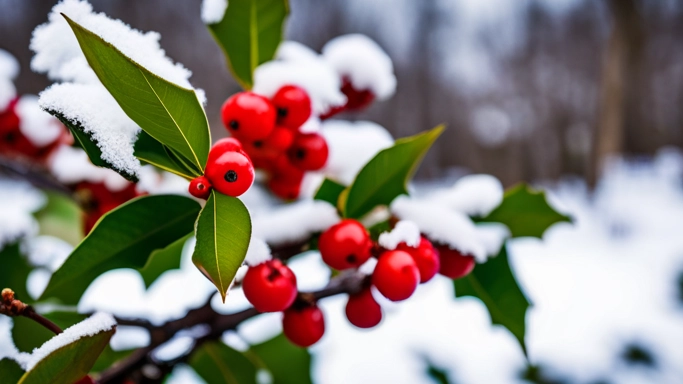
Esoteric Traditions of the Holly Tree
In various esoteric traditions, the wood of the Holly Tree is believed to carry protective qualities. It is often used in the making of wands, staffs, and other ritual tools in practices that involve protection, dream magic, and enhancing spiritual strength. The wood’s connection to the Holly tree’s symbolism of resilience and protection makes it a choice material in such contexts. The tree is often associated with strength, protection, and the balancing of masculine and feminine energies.
The term “Hollywood,” famously synonymous with the American film and media industry, carries an immense influence on modern culture and societal norms. “Hollywood” as an entity wields a comparable influence in shaping narratives, trends, and ideals in modern society. The industry, much like the tree, has roots that delve deeply into the fabric of modern life, extending its branches across global cultures and communities, thereby profoundly impacting how we perceive, understand, and interact with the world around us. The Druid wizard Merlin, from the legend of King Arthur, is said to have used a wand made of Holly wood.
The Holly in Celtic Mythology and Druidism
In ancient Celtic traditions, the Holly tree was highly revered. It was believed to possess protective qualities, warding off evil spirits, witchcraft and bad luck. Druids considered the Holly as a symbol of fertility and eternal life. The tree’s ability to remain green throughout the year made it a powerful symbol in a culture that revered nature and seasonal cycles. The Holly King was said to rule the second part of the year.
The Holly In Christian Symbolism
In modern Christian symbolism, the Holly tree is often associated with Christmas. Its evergreen nature symbolizes eternal life, while the red berries are thought to represent the blood of Christ. The pointed leaves have been interpreted as a symbol of the crown of thorns worn by Jesus during the crucifixion.
The Holly in the Winter Solstice
The Holly was an important plant in winter solstice festivities, especially in pre-Christian times. Its evergreen nature was a reminder that life would return to the earth after winter. It was often brought into homes to provide shelter to good spirits during the cold, dark winter months.
Roman Mythology related to the Holly Tree
In Roman culture, Holly was associated with Saturnalia, a festival in honor of Saturn, the god of agriculture and time. Holly wreaths were given as gifts during this festival, which could be seen as a precursor to the modern Christmas wreath tradition.
Holly Tree – Folklore and Protection
In various folklore traditions, Holly trees were believed to have protective properties. Planting a Holly tree near a home was thought to protect the inhabitants from lightning strikes and evil spirits. It was also believed that cutting down a Holly tree would bring bad luck.
Healing and Medicinal Uses of the Holly Tree
In some New Age practices, Holly wood is used for its perceived vibrational properties. It’s thought to resonate with energies that promote healing, particularly emotional and spiritual healing. Practitioners might use Holly wood in meditative practices or carry it as a talisman for these purposes.
Historically, parts of the Holly tree were used in traditional medicine. The leaves, berries, and bark were used for various medicinal purposes, though it’s important to note that Holly berries are toxic if ingested.
Astrological Associations of the Holly Tree
In some traditions, Holly is associated with the planet Mars, symbolizing its fiery energy and protective qualities.
Each of these aspects reflects the deep cultural and spiritual significance of the Holly tree, illustrating how it has been interwoven into various belief systems and practices throughout history.
2 Araucariaceae Family
The Araucariaceae family is a fascinating group of ancient conifers that has been gracing our planet for as long as we can remember, and possibly Enoch. The family stands out for its unique features and historic significance.
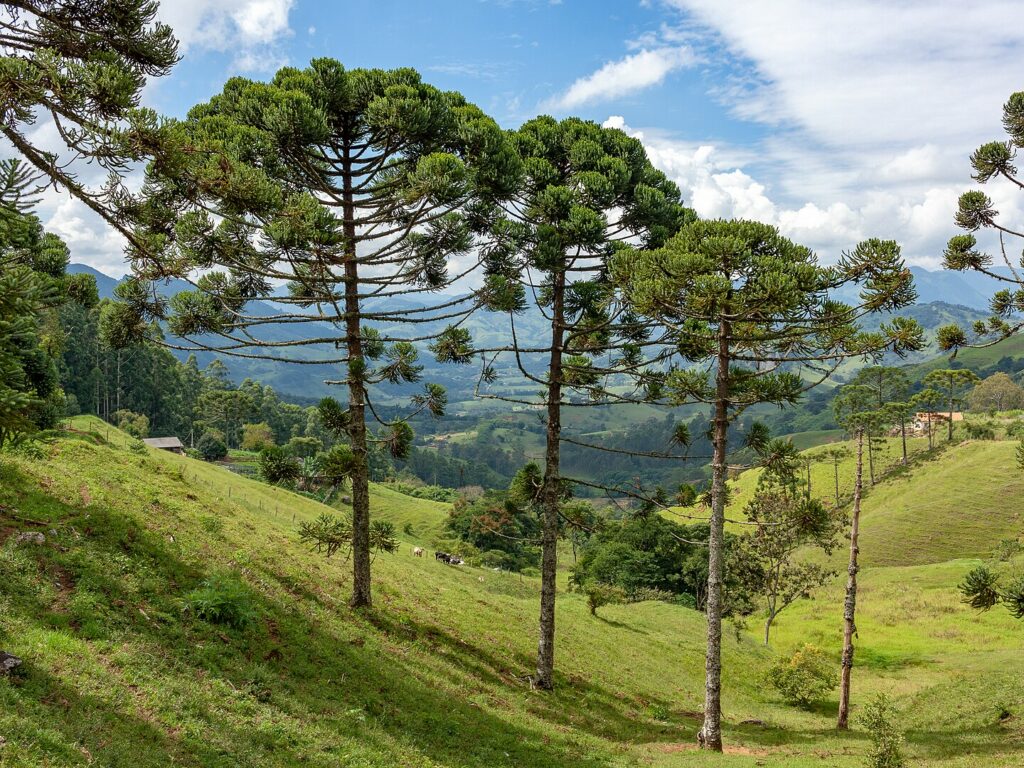
Let’s take a closer look at its three main types:
- Araucaria: Often called ‘Monkey Puzzle Trees’, Araucaria species are known for their distinctive, spiral arrangement of branches and tough, scale-like leaves. These trees are not just a visual marvel; they’re living relics, with some species dating back to the Mesozoic era. They’re commonly found in South America and Australia, where they play a vital role in their ecosystems.
- Kauri (Agathis): The Kauri trees, native to New Zealand and parts of the Pacific, are revered for their massive size and longevity. These giants of the forest can live for thousands of years and have been an integral part of the indigenous Maori culture. The Kauri’s resin, known as Kauri gum, was historically significant for various uses.
- Wollemi Pine (Wollemia): A sensational discovery in the world of botany, the Wollemi Pine was known only from fossils until it was discovered alive in Australia in 1994. Dubbed a “living fossil,” the Wollemi Pine is a rare and critically endangered species, offering a living snapshot of ancient ecological history.
Each of these trees tells a story – a story of survival, adaptation, and the incredible journey of life in our realm. The Araucariaceae family is a testament to the resilience and diversity of conifers, standing as a living link to the Earth’s distant past.
Araucariaceae Tree Family in Folklore and Legend
The Monkey Puzzle tree, native to South America holds cultural importance among the indigenous Mapuche people. In Mapuche mythology, these trees are sacred and are often found near religious sites.
Healing and Medicinal Properties of the Araucariaceae Tree Family
While prominently known for their medicinal properties, certain species within the Araucariaceae family have been used in traditional medicine by indigenous communities. For example, the resin or sap of some Araucaria species has been used for treating wounds and skin ailments, owing to its supposed antiseptic properties.
3 Arecaceae Family
The Arecaceae family symbolises tropical allure. Commonly known as palm and coconut trees, these plants are celebrated for their distinctive role in tropical landscapes. Their ecological and economic significance extends from providing coconut and palm oil to featuring in numerous cultural and religious practices.

Palm and Coconut trees stand as symbols of life, sustenance, and resilience. Beyond their obvious economic value, these trees are deeply rooted in esoteric traditions, local customs, mythology, and natural medicine, offering a rich narrative that spans cultures and continents.
Esoteric Traditions of the Arecaceae Tree Family
Within esoteric circles, palms have long been symbols of victory, peace, and eternal life. Their leaves are used in various spiritual and ritualistic practices across cultures, signifying triumph and enlightenment. In tarot, the Ace of Cups, often depicted with the palm, represents emotional and spiritual abundance, highlighting the tree’s deep spiritual significance. The Coconut tree, with its ability to thrive in sandy soils and provide life-sustaining resources, is seen as a symbol of resilience, self-sufficiency, and prosperity in many spiritual traditions.
Local Traditions of the Arecaceae Tree Family
In the Pacific Islands, the Coconut tree is revered as the “Tree of Life” due to its vital role in providing food, shelter, and other necessities. Similarly, in the Caribbean and tropical regions, palms are integral to the cultural fabric, featuring prominently in festivals, art, and architecture. They represent a connection to nature’s bounty and the ancestral wisdom of living in harmony with the earth.
Mythology and Folklore of the Arecaceae Tree Family
Palms and coconuts are sometimes associated with sacredness and mystique. In Hindu mythology, the Coconut is considered a divine fruit, offered to gods in rituals and ceremonies as a symbol of purity and auspiciousness. Palms, with their sun-seeking fronds, are often associated with sun gods in various cultures, embodying solar attributes such as vitality, fertility, and eternal life. Tales from the Arabian Nights, to Caribbean lore, celebrate the palm as a tree of life, a source of nourishment, and a protector from the elements.
Healing and Medicinal Uses
The Arecaceae family’s contribution to natural medicine is extensive. Coconut oil is noted for its antimicrobial, anti-inflammatory, and moisturising properties. The water and flesh of the Coconut are rich in nutrients and electrolytes, offering natural hydration and energy sustenance. Beyond the Coconut, various parts of palm trees are used in traditional medicine across the world to treat various ailments, from digestive issues to skin infections.
4 Cupressaceae Family
The Cupressaceae family includes a range of coniferous trees and shrubs. Known for their aromatic wood and scale-like leaves, these trees are integral to both ornamental gardening and timber industries, and their distinctive, often columnar, forms are a staple in landscapes worldwide. The Giant Redwoods of California are some of the largest trees in the world.

Members of the Cupressaceae family include:
- Cypress – native to various parts of the world but prevalent in Mediterranean and North America. Noted for durable, aromatic timber that resists decay.
- Juniper – largely located in the Northern Hemisphere, Juniper trees produce a dense, fragrant wood that’s used in woodwork and as a flavouring agent in cuisines and beverages, most notably gin.
- Redwood (Sequoia) – Coast Redwoods and Giant Sequoias, are native to the coastal regions of California, where they grow to a huge size. Rot-resistant timber is now protected and prized for construction and decorative uses due to its durability and beauty.
- Thuja – Native to North America and parts of Asia, Thuja trees are commonly used in ornamental landscaping for their dense foliage and fast-growing nature; their light, softwood is popular for crafting and in the production of shingles and siding.
- Cryptomeria – Also known as the Japanese Cedar, this tree is primarily found in Japan, where it is cultivated for its lightweight, straight-grained wood in furniture and crafts.
Esoteric Traditions of the Cupressaceae Family
The Cypress tree, with its tall, slender form reaching towards the heavens, has been a symbol of mourning but also eternal life, serving as a bridge between the earthly and the divine. In many cultures, Cypress trees are planted in sacred spaces and graveyards, guiding souls on their journey beyond
Juniper, with its protective qualities, is often used in purification rituals. Burning Juniper branches or berries is believed to cleanse a space of negative energies, inviting protection and healing. This practice, found in various forms across different cultures, highlights the tree’s role in esoteric healing and protection.
Local Traditions of the Cupressaceae Family
Local traditions abound with reverence for these ancient trees. In Japan, the Cryptomeria, or “Sugi,” is considered sacred, often surrounding Shinto shrines and temples. These towering trees create a serene, purified atmosphere, embodying the Japanese concept of “shinrin-yoku” or forest bathing, where immersion in the forest air is a practice of healing and rejuvenation
The Redwood, particularly the Coast Redwood (Sequoia sempervirens), is deeply ingrained in Native American traditions. These magnificent trees, among the tallest and oldest living beings on Earth, are seen as powerful ancestors, providing wisdom and a connection to the past. Tribes in the Redwood region have used the tree’s bark and wood for building, crafting, and ceremonial purposes, respecting its spiritual and physical gifts.
Cupressaceae Family Mythology and Folklore
Mythology and folklore have immortalized the Cupressaceae family in tales of gods, mortals, and the natural world. Ancient Greek legends tell of Cyparissus, a youth beloved by Apollo, who was transformed into a Cypress tree, symbolizing sorrow and mourning. This story echoes through time, illustrating the deep connections humans have with trees as symbols of life, death, and rebirth.
In Norse mythology, the Juniper is associated with protection and strength. It was believed that Juniper could ward off evil spirits and ensure the safety of those who kept it close. This protective aspect is mirrored in folklore across Europe, where Juniper was used in rituals and amulets to safeguard against harm.
Healing and Medicinal Uses of the Cupressaceae Family
Beyond their symbolic significance, the Cupressaceae family is renowned for its healing and medicinal properties. Thuja, for instance, has been used in traditional medicine for its antiviral and immune-boosting qualities. Essential oils derived from Thuja leaves are applied in aromatherapy and natural remedies for skin conditions and respiratory ailments.
Juniper berries, rich in essential oils and compounds, have been used for centuries in herbal medicine. Their diuretic, antiseptic, and digestive properties make them a valuable ingredient in treatments for urinary tract infections, digestive issues, and rheumatic pain.
5 Cyatheaceae Family
The Cyatheaceae family comprises tree ferns. These ancient plants, with their towering trunks and large fronds, are living fossils that offer a glimpse into the prehistoric world. They are essential to the undergrowth of the forest ecosystem.

Esoteric Traditions of Tree Ferns
In various spiritual traditions, tree ferns are seen as symbols of growth, resilience, and the ability to thrive in the shadows. Their preference for moist, shaded forests parallels the esoteric principle that enlightenment can be found in the darkness of the unknown. Practitioners of modern paganism and druidism often regard tree ferns as guardians of ancient wisdom, embodying the connection between the underworld and the physical world.
Local Traditions of Tree Ferns
In the regions where they flourish, such as New Zealand, Australia, and South America, the Cyatheaceae are woven into the fabric of local traditions. The New Zealand Māori revere the Ponga (Cyathea dealbata) for its utility and symbolic significance. Its fronds are used in traditional arts, crafts, and as symbols of status and honor. In the Māori cosmology, tree ferns are considered to hold the secrets of the land, offering protection and guidance.
The Silver Fern is the emblem on the shirts of the world famous New Zealand All Blacks Rugby Team.
Tree Ferns in Mythology and Folklore
The lore surrounding tree ferns is as rich and varied as the ecosystems they inhabit. In some South American indigenous cultures, tree ferns are believed to house spirits of the forest, serving as a bridge between the human and spirit worlds. Stories depict them as ancient beings that possess deep knowledge of the earth, capable of communicating through dreams and visions.
Healing and Medicinal Uses of Tree Ferns
Certain species within the Cyatheaceae family have been used in traditional healing practices. The indigenous peoples of Australia and New Zealand have used parts of tree ferns for wound dressing and to treat skin conditions, relying on their antibacterial properties. In some cultures, the core of young tree ferns is consumed for its nutritional value and believed to possess health-enhancing qualities.
6 Cycadaceae Family
The Cycadaceae family is home to the cycads. These ancient, palm-like plants have a prehistoric lineage and are known for their distinctive crown of stiff, evergreen leaves and stout trunks. Cycads are known for their ornamental value and intriguing reproductive structures, resembling cones

- Cycads
7 Fagaceae Family
The Fagaceae family features prominent trees like oaks and beeches. These trees are known for their strong wood, lobed leaves, and fruits such as acorns. They play a crucial ecological role in temperate forests and are highly valued for their timber, ecological significance, and historical importance.

- Beech
- Pine
- Oak
8 Lauraceae Family
The Lauraceae family includes notable members like laurels, cinnamon, and avocado. These evergreen trees and shrubs are celebrated for their fragrant leaves and significant contributions to both culinary and medicinal uses, alongside their ecological importance in forest ecosystems.

- Laurel
- Bay
9 Magnoliaceae Family
The ancient and magnificent magnolias are renowned for their large, showy flowers and represent a vital link in the evolutionary history of plants. Magnolias hold a special place in horticulture and traditional medicine across various cultures.
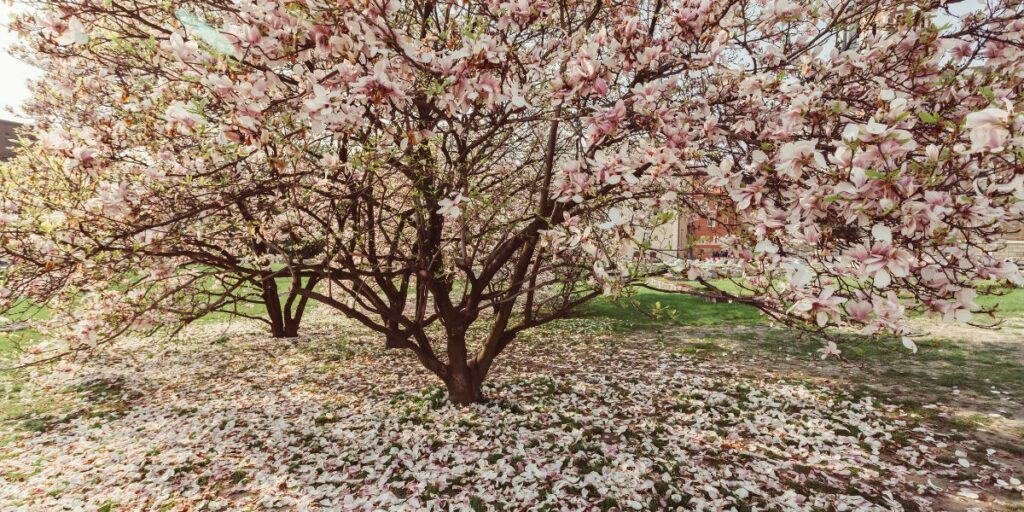
- Magnolia
10 Myrtaceae Family
The Myrtaceae family is a diverse group including eucalyptus, guava, and clove. Known for their aromatic leaves and variously sized flowers and fruits, these plants have widespread uses in medicine, culinary arts, and as ornamental plants.
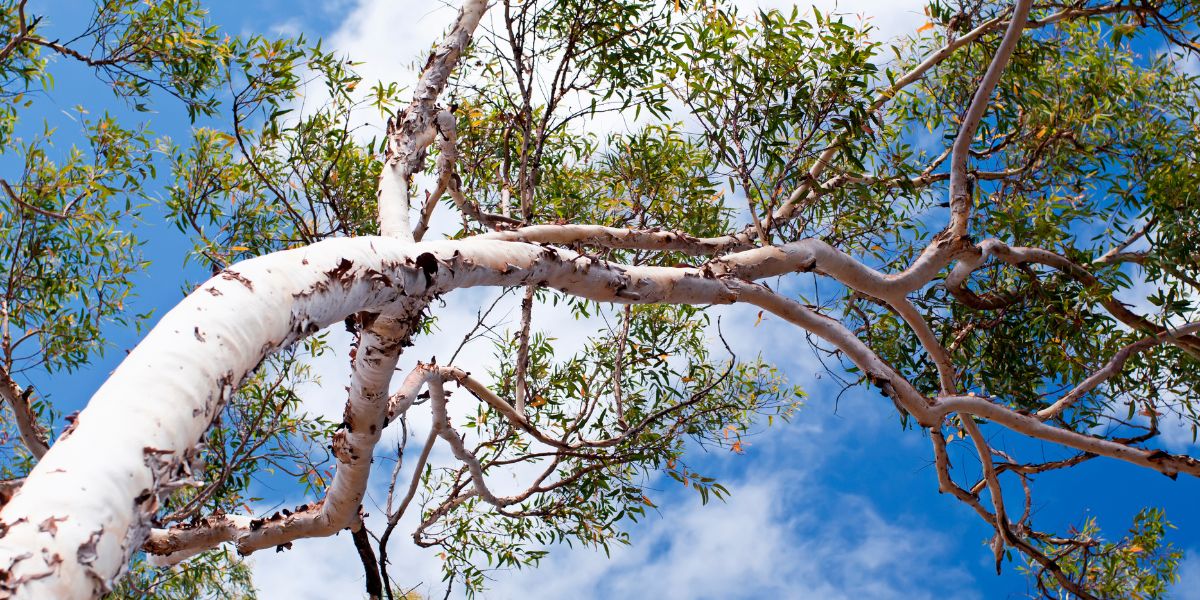
- Myrtle
- Rum
- Clove
- Guava
- Spice
- Eucalyptus
11 Oleaceae Family
The Oleaceae family of trees is known for its economic and cultural significance, particularly the olive tree, which symbolises peace and is vital in culinary traditions. Their flowers and fruits provide various uses, from perfumery to food.
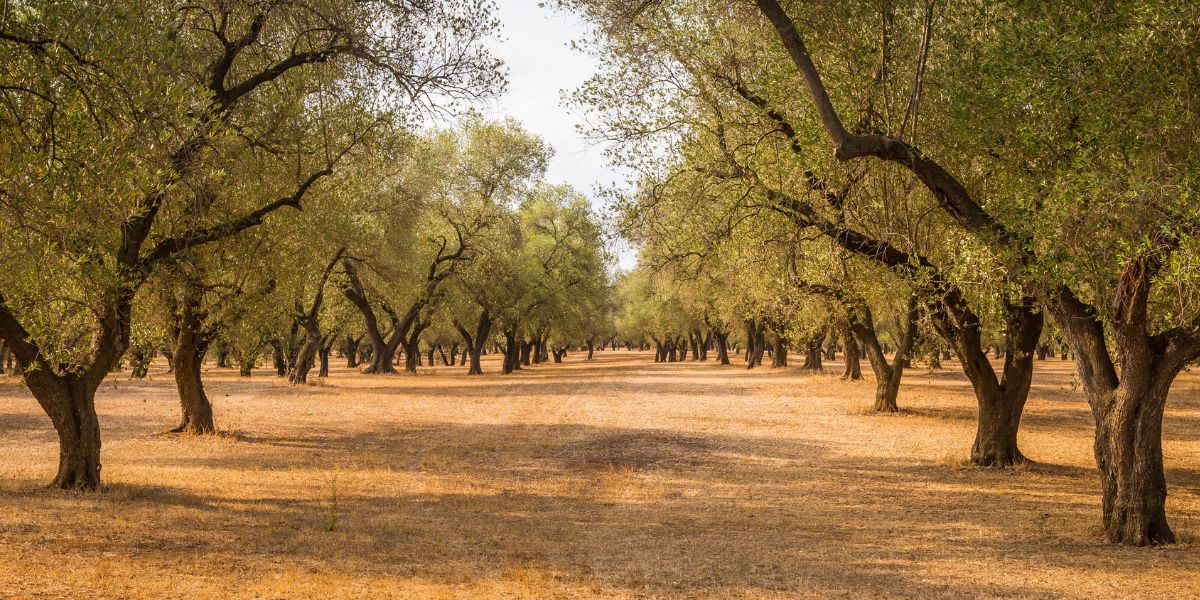
- Olive
- Tropical Ash
12 Pinaceae Family
The Pinaceae family is home to many well-known conifers like pines, firs, and spruces. These trees are known for their needle-like leaves and conical growth form.
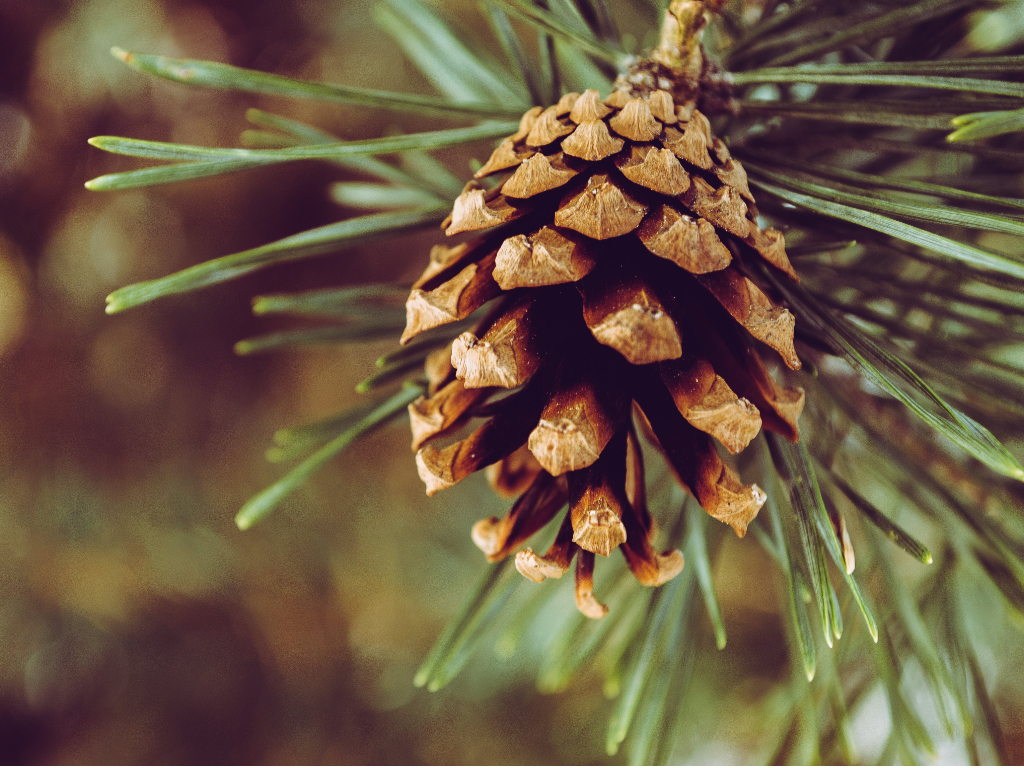
- Pine
- Spruce
- Cedar
- Hemlock
13 Podocarpaceae Family
Mostly found in the Southern Hemisphere, the Podocarpaceae family are conifers concentrated in New Zealand, Australia, South America, and Southeast Asia. These trees and shrubs are known for their diversity in form and size, from towering trees to low shrubs, and are important both ecologically and culturally in their native regions.
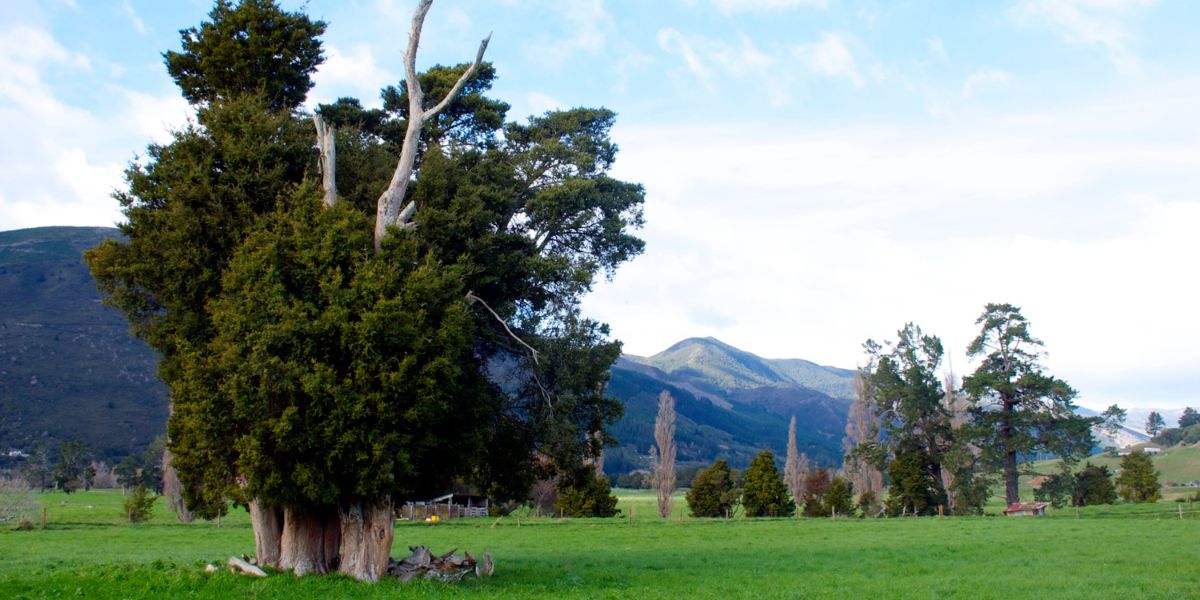
Examples of Trees in the Podocarpaceae Family
- Totara (Podocarpus totara): Native to New Zealand, this tree is known for its durability and sacred status in Māori culture.
- Rimu (Dacrydium cupressinum): Another New Zealand native, Rimu is a slow-growing tree valued for its timber.
- Kahikatea (Dacrycarpus dacrydioides): The tallest native tree in New Zealand, important in Māori culture.
- Real yellowwood (Podocarpus latifolius): A significant and iconic tree in South Africa, known for its beauty, longevity, and the quality of its timber. It’s a slow-growing evergreen tree that can reach impressive ages, with some specimens estimated to be over a thousand years old.
- Long-leafed Yellowwood aka Oleander Podocarp or Brown Pine (Podocarpus neriifolius): Found in South and Southeast Asia, it’s known for its long, narrow leaves.
14 Taxaceae Family
The yew family, known for their longevity and distinctive red arils. These conifers, often with dark, evergreen leaves, are celebrated for their ornamental value and medicinal properties, notably the cancer-fighting compound found in some species.
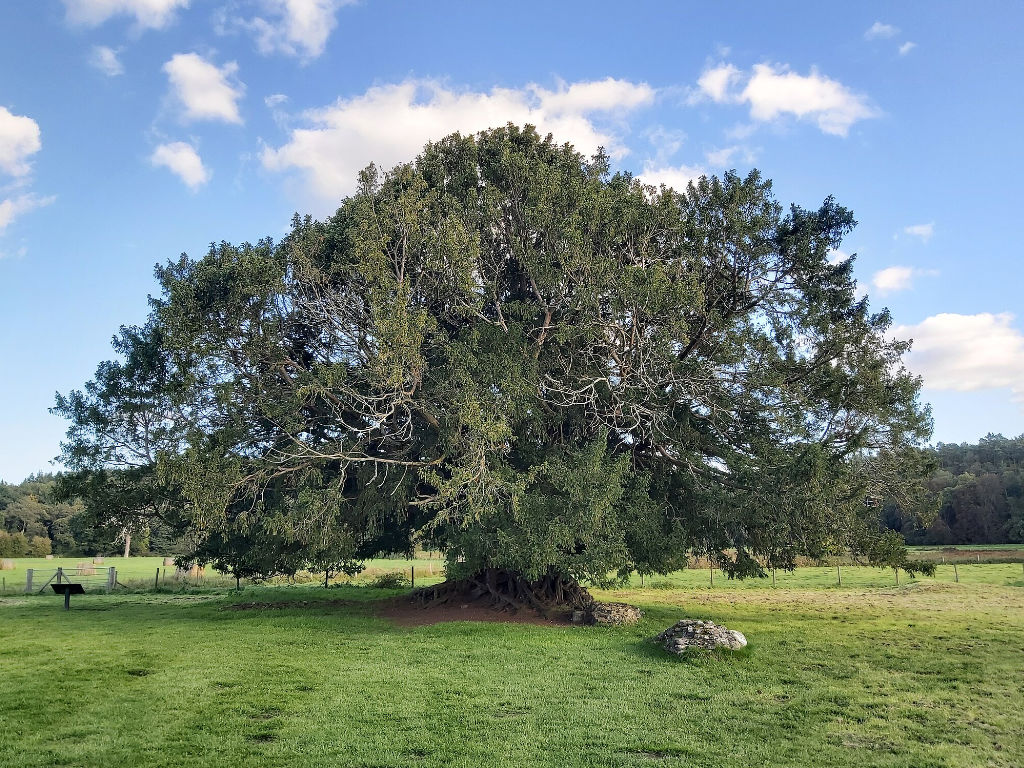
- Yew
There also a number of Evergreen Trees that don’t fit into the “Evergreen families”, such as:
- Rutaceae Family:
- Citrus limon (Lemon Tree)
- Citrus sinensis (Orange Tree)
- Citrus aurantifolia (Lime Tree)
- Oleander Family (Apocynaceae):
- Nerium oleander (Oleander)
- Ericaceae Family:
- Rhododendron spp. (Rhododendrons and Azaleas)
- Theaceae Family:
- Camellia sinensis (Tea Plant)
- Camellia japonica (Japanese Camellia)
- Sapotaceae Family:
- Manilkara zapota (Sapodilla)
These trees are evergreen but belong to different botanical families than the fourteen primary Evergreen families. Each of these families has its unique characteristics and botanical significance.





8 Responses
Is it Enoch 3:1 or Enoch 4:1?
Enoch 4::1
It is Enoch 2:3
Enoch 3:1 for sure
Amazingabout the great findings from the book of Enoch
What about this (15th?) one?
From Wikipedia:
“Japanese umbrella pine is unique in that it has its own family of which it is the only species”
This is Fascinating!
Citrus trees are evergreen trees aswell apprently i was just thinking why looking at my lemon tree that it’s leaves haven’t withered away and the verse of Enoch came to mind so I looked it up and citrus trees are apprently lemon trees too praise Yah that people are reading Enoch